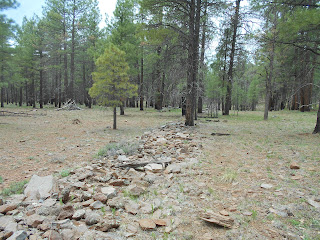FLAGSTAFF AREA LOGGING RAILROADS; ALLEN LAKE LINE:
SAGINAW AND MANISTEE LUMBER COMPANY.
COPYRIGHT; ALL RIGHTS RESERVED (5/10/22)
The Allen Lake Line was located in Flagstaff, Arizona, extending to just south of Mormon Lake. This line became part of the Saginaw and Manistee Lumber Company. Once the operation was closed in Williams, Arizona, the company migrated to the leased mill in Flagstaff. The Allen Lake Line was the main route wherein the company reached the timber holdings south of Mormon Lake. This is normally out of the my research area, but you will soon agree it was worth the trip.
On March 1, 1941, the Saginaw and Manistee leased the Arizona Lumber and Timber Company from manager Joe Dolan. The S&M had acquired vast timber holdings in the area of Mormon Lake, and the lease of the AL&T allowed them to harvest these holdings. The Saginaw extended the Howard Spring line, extending it for 14 miles to Allan Lake, located South of Mormon Lake. With the exception of one spur, the railroad line was served by trucks bringing logs to the railhead. Mechanized logging had replaced the need to constantly relay spurs into the forest. A steady flow of quality timber was provided to the leased Flagstaff mill, and during WWII made a significant contribution to the war effort. SouthWest Lumber Mills took control of the AL&T and the Saginaw lease in 1952-53. The next reorganized company, South-West Forest Industries, ran the line until March of 1966 (Kuhn 1981:101; Glover 1965; Stein, Report #19, page33.)
RED designates railroad grade, as it follows FR91 and FR700. Terminus is south of Mormon Lake, at Howard Spring. Near the end, the satellite view shows a "Y." ORANGE designates canyon area, along FR91A. The area where the trestle is located is highlighted at the top left hand side of the map.
Where the road meets FR91. Looking West.
A forest road splits to to the left, this is where the roadbed connects with FR91.
Looking southeast, where the original roadbed heads to Allen Lake.
This road is marked closed to vehicles.
A close-up view of the tank site. It does appear that the tank may have been placed upright, but was later knocked over for safety reasons. A large amount of rock work indicates it was an important site, with additional structures.
At the tank, a riveted pipe next to a newer culvert
Further along the grade are other culverts. Several of them are made of metal (iron?) plates, riveted together, giving some idea as to their age. Possibly old tank cars, repurposed as culverts?
Evidence of logging along the road.
The Arizona Lumber and Timber Company built the large trestle in 1929-1930, and was later rebuilt by the Saginaw and Manistee when they leased the line until 1952. Subsequent owners used it until 1966. The trestle structure measures 335 feet long, 30 feet wide at the base, and 22 feet wide at the top. At its highest point it measures 12-15 feet (Stein, Report #19,page 190.) Sections of the trestle have fallen away, revealing the methods used in its construction. The internal structure is made up of logs, cut and placed perpendicular to the direction of the trestle. On top of this, loose fill of rocks were used to complete the core. As it was built up, the sides were tapered to increase strength, then covered in stacked, flat masonry rockwork. It appears that repairs were made, and the structure was widened, again covered in flat masonry rockwork. Stein best describes it as "cribwork trestle with rock fill and facing (pg.191.)" I couldn't have said it better... This monolith is visible on Google maps, satellite view.









































No comments:
Post a Comment